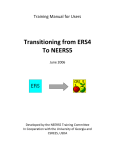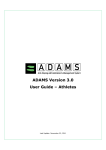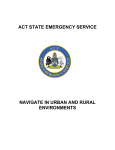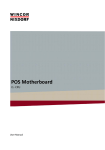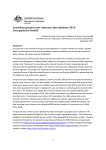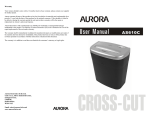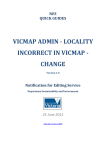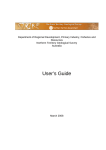Download Specification and User Guide - Centre for Spatial Data
Transcript
Specification and User Guide Spatially Enabling Health Data in the Mitchell and Murrindindi Shires For Lower Hume Primary Care Partnership July-November 2008 Prepared by Centre for SDIs and Land Administration Department of Geomatics, The University of Melbourne Specifications Introduction This part of the report will explain different features of the GIS system developed. It is then followed by a user guide to help users in different level of familiarity with GIS to use the system. System Requirements ArcGIS 9.2 (www.esri.com) has been selected as the main GIS platform of the project. The software could be installed on any medium range desktop/laptop computer (such as Intel Core2) and needs at least 1 GB of Ram and around 50 GB of hard disk for a smooth operation. Also, MapInfo 8 (particularly Universal Translator function, Figure 2.) has been used for data conversion process as most GIS data provided by Land Victoria were in MapInfo format. Data Preparation The required data in this project was provided from different sources. The following Table illustrates major data sources in the project. Table1. Major data sources in the project Data Provider Data Department of Sustainability and Environment (Land Victoria) (www.land.vic.gov.au) Australian Bureau of Statistics (ABS) (www.abs.gov.au) Department of Human Services Victoria (DHS) (www.dhs.vic.gov.au) Victorian Government Health Information (www.health.vic.gov.au) - VicMap Property (Parcel and Property Boundaries, Cadastre map) - VicMap Transportation (Roads and Rails) - VicMap Localities (Local Government Areas) - VicMap Hydro (Rivers, Lakes, …) - Post codes boundaries in the study area - Mesh Blocks (Land use, No of dwellings, Population …) - Demographic and Socioeconomic Information extracted from Census 2006 data including: Age, Gender, Income … - Quick Stats - Regional Victorian Public Hospitals - Regional Victorian Private Hospitals - Directory of services in the study area - The Home & Community Care (HACC) Better Heath Channel (www.betterhealth.vic.gov.au) - Directory of services in the study area Mitchell and Murrindindi Shires websites (www.Mitchellshire.vic.gov.au) (www.Murrindindi.vic.gov.au) - General Information about the shires, boundaries, etc. Land Victoria - VicMap Property (Parcel and Property Boundaries, Cadastre map) - VicMap Transportation (Roads and Rails) - VicMap Localities (Local Government Areas) - VicMap Hydro (Rivers, Lakes, …) - Post codes boundaries in the study area Australian Bureau of Statistics Department of Human Services - Mesh Blocks in Study Area (Land use, No of dwellings, Population …) - Demographic and Socioeconomic Information extracted from Census 2006 data including: Age, Gender, Income … - Quick Stats Victorian Government Health Information Better Heath Channel Descriptive Data - Directory of services in the study area - The Home & Community Care Conversion/Mapping/Geo-coding Data Format Check No Conversion to ESRI Shape file Maps Yes GIS Platform (ESRI ArcGIS 9.2) Spatial/Non Spatial Analysis Reports Kml /Kmz (Google Earth) Figure1. Data preparation process Figure1. demonstrates the data preparation process in the project. Department of Sustainability and Environment (Land Victoria) was the main source of infrastructure and administration boundaries information in the GIS system. Spatial information in the form of GIS layers such as VicMap Property (Parcel and Property Boundaries, Cadastre map), VicMap Transportation (Roads and Rails), VicMap Localities (Local Government Areas), VicMap Hydro (Rivers, Lakes, …), and finally Post codes boundaries in the study area were obtained from Land Victoria in the MapInfo format. The conversion of GIS layers from MapInfo (.Tab) to ArcGIS (.Shp) could be done in two ways, first in MapInfo environment by using The Universal Translator feature (Figure 2.) or in ArcGIS environment by using extensions such as TabReader which allows direct import and using Tab files in ArcGIS. Australian Bureau of Statistics (ABS) was another major source of data in the project. Most of the Demographic and Socioeconomic information were extracted from Census 2006 data. Age, Gender, Income, etc are the most common data that could be available at ccd (census collection districts) level. Each ccd contain information of about 200 dwellings. The other major information available through ABS website was the Mesh Block information. Mesh Blocks are more detailed units for data and each Block contains around 50 dwellings information. Land use, population and dwelling numbers are among the information provided in mesh block level. Department of Human Services (DHS), Victorian Government Health Information and Better Health Channel were also other sources of information in this project. Figure2. Universal Translator in MapInfo Product Description for Land Victoria Data CUSTODIANSHIP OF EACH SET OF DATA Victorian Township and Parish Boundaries - Department of Sustainability & Environment Victorian Locality Boundaries – Department of Sustainability & Environment Victorian Local Government Boundaries – Department of Planning and Community Development Victorian Local Government Ward Boundaries – Department of Planning and Community Development Victorian Government Regional Departmental Boundaries – Department of Planning and Community Development Victorian Electoral Boundaries – Victorian Electoral Commission Victorian Postcode Boundaries – Australia Post Department of Sustainability & Environment Regional Boundaries - Department of Sustainability and Environment By arrangement, the Custodians have determined that the above datasets will be maintained by: Spatial Information Infrastructure Department of Sustainability and Environment Level 13 Marland House 570 Bourke Street MELBOURNE VIC 3000 - Jurisdiction State of Victoria, Australia - Description Vicmap Admin comprises several individual datasets. Each is topologically structured and models all designated and gazetted boundaries across the whole of Victoria. • Geographic extent Vicmap Admin content covers the entire state of Victoria. • Content The Vicmap Admin product records administrative boundaries as defined by the Custodian. These attributes are detailed in the detailed Product Descriptions of the individual dataset. • Structure The Vicmap Admin spatial data set consists of a series of lines and polygons. The lines depict administrative boundaries, which in turn, define a state-wide coverage of contiguous non-overlapping polygons. In combination these polygons represent the entire administration area of Victoria. Point data will not be included in the present structure of the Vicmap Admin data set. • Reference systems The base reference system for Vicmap Admin is GDA94: Geographical (latitude/longitude). Other reference systems supported include: • AMG66: Australian Map Grid (cartesian coordinates); and • AGD66: Geographicals • MGA94: Map Grid of Australia (cartesian coordinates). • Features of note Vicmap Admin is intended to accurately record the location of the boundaries represented. This means that changes occur on an irregular basis in response to administrative boundary reviews conducted by the respective Custodian. Versions of the information product will be clearly identifiable. Features of note include: • Unique Feature Identification (each feature uniquely identified for change management). • Updates provided as whole file replacement. • Temporal Data Management (features date stamped - data retired, effective date, no data is deleted). • Related data sets Vicmap Admin forms part of the State of Victoria’s Framework Information spatial data infrastructure. Vertical alignment will be primarily based on associated Vicmap products such as Vicmap Property for cadastral boundaries and Vicmap Transport for road centreline and railway alignment detail. • Reference tables Reference tables are used in the production and maintenance of Vicmap Admin. These reference tables are held by Department of Sustainability and Environment in an Oracle database and are available in most database, spreadsheet and delimited formats. Copies are available on Department of Sustainability and Environment’s GIS web site: www.land.vic.gov.au. Copies may also be obtained directly from Department of Sustainability and Environment. - Production and/or Acquisition Methods Vicmap Admin clearly defines administrative boundaries in terms of their underlying spatial features, such as property boundaries, railway lines, creek banks and road centrelines. Vicmap Admin is a component part of the Vicmap suite of Victoria-wide Framework Information products. Vertical alignment with underlying property or transport data is a priority and where ever possible has been achieved. Variation or non-alignment occurs due to data origins, and/or the differing nature of content, and/or the requirements and constraints at the time of construction of the datasets. For example, the origin of much topographic data is the State’s 1:25,000 standard mapping program and the origin of much cadastral data varies from direct input survey co-ordinates to 1:25,000 property/parcel mapping. Other issues relate to temporal factors. For example, the topographic representation of a stream bank in Vicmap Hydro will be what exists today; the cadastral representation of the same stream bank in Vicmap Property will be what was surveyed at the time of alienation. Whilst observation has shown that the alignment of the same or similar features across these data sets is extraordinarily good, scale variation, temporal issues and feature definition will result in variance in many cases. Whilst full vertical alignment is being targeted by Department of Sustainability and Environment, these manifold issues will delay its final achievement. Whilst these alignment issues are being attended to, the difficulty to Department of Sustainability and Environment and Vicmap users is the need for two versions of the same Vicmap Admin data. One version will be aligned to the cadastre (Vicmap Property) and the other aligned to topographic features (Vicmap Transport, Vicmap Hydro, etc). In many cases, the two versions will be the same, or similar, however there may be differences due to those fundamental variations highlighted above. KEY SOURCE OF INPUT DATA Each respective Custodian determines the true and correct definition of administrative boundaries. This information is interpreted as part of the maintenance regime undertaken by Department of Sustainability and Environment. The Custodian subsequently validates its final representation in Vicmap Admin. - Currency & Status Administrative definition is determined by the Custodian. On receipt of any realignment advice from the custodian, Department of Sustainability and Environment will immediately forward such information to its data maintainers for inclusion into Vicmap Admin. - Spatial Accuracy The accuracy of this data set has not been specifically determined. Where it aligns with underlying elements in related Vicmap products such as Vicmap Property or Vicmap Transport, its accuracy will be that of the underlying feature. For information regarding these products, please refer to their product specifications. Copies are available on Department of Sustainability and Environment’s GIS web site at www.land.vic.gov.au. - Feature and Attribute Accuracy For this product, feature and attribute accuracy is a measure of the degree to which the features and attribute values of spatial objects agree with the information on the source material. The maximum allowable error in attribute accuracy is 1%. - Completeness The reliability figures indicating completeness of content between the dataset and the source material for administrative definition is 99%. - Logical Consistency Logical consistency is a measure of the degree to which data complies with the technical specification. The maximum allowable error in logical consistency is 1% for maintenance activity. The test procedures are a mixture of software scripts and onscreen, visual checks. METADATA Metadata at Anzlic Page 0 level has been created and is included in the Victorian Spatial Data Directory (VSDD). Page 0 Metadata may be viewed via the government Land Information website, Land Channel, at http://www.land.vic.gov.au/. Product Description for ABS Data (Mesh Blocks) DATASET CUSTODIAN - Title: Mesh Blocks (2006) Digital Boundaries, Australia (ABS Cat. No. 1209.0.55.002) - Custodian :ABS Geography Section: [email protected] DESCRIPTION - Abstract: These digital boundaries represent Mesh Blocks which are the smallest geographical unit for which ABS data will be output. Mesh Blocks will be integrated into the ABS's statistical geography for the 2011 Census. These Mesh Blocks are currently experimental and contain basic 2006 Census data (total usual resident population and dwelling count). Mesh Blocks are identified with a unique 11 digit code. - Geographic Extent Name Geographic Australia; including the external territories of Cocos (Keeling) Islands & Christmas Island but excluding all other external territories. - Data Currency Beginning date: November 2004 End date: Contains updates in underlying topographic data up to August 2007. - Data Status Progress: On-going Maintenance and Update Frequency: On-going DATA ACCESS - Stored Data Format Digital MapInfo files - Available Format Type MapInfo mid/mif and ESRI Shapefiles - Access Constraints Copyright Commonwealth of Australia administered by the ABS. DATA QUALITY - Lineage Mesh Blocks boundaries were created using various sources including the PSMA digital topographic datasets and ABS SLA boundaries, zoning information from state planning agencies and imagery. - Positional Accuracy The PSMA topographic database to which boundaries are aligned was captured at scales which vary from 1:4,000 in urban areas to 1:250,000 in remote areas. - Attribute Accuracy Mesh Block codes & labels are fully validated. - Logical Consistency Spatial units are closed polygons. These data include attribute records without spatial objects for administrative purposes. - Completeness The 2006 Mesh Blocks are represented in their entirety. CO-ORDINATE SYSTEMS - Datum Geocentric Datum of Australia 1994 (GDA94) - Projection Geographical (ie latitudes and longitudes) - Metadata Date February 2008 - Additional Metadata Reference: Information Paper: Draft Mesh Blocks, Australia (Reissue), 2005 (ABS Cat. No. 1209.0.55.001) ATTRIBUTE INFORMATION (Mesh Blocks) FILE ATTRIBUTES File Type Mesh Block (MB) Field Name MapInfo Files Field Name Shapefiles MB_Code MB_Code Type Comments Float 11 digit Mesh Block code MB_Category Category Total_UR_Population_2006 TURPOP2006 Character Landuse category Float Total Usual Resident population Float Total dwellings Character Imputation rate quality indicator Date Records change date for the MB Total_Dwellings_2006 MB_Imputation_Rate TDWELL2006 Imput_Rate MB_Date_Modified Date_Mod MB_Code:An 11 digit field with the first digit being the state code. The State/Territories are identified by unique one digit codes as follows: 1 = New South Wales 2 = Victoria 3 = Queensland 4 = South Australia 5 = Western Australia 6 = Tasmania 7 = Northern Territory 8 = Australian Capital Territory 9 = Other Territories Note that there are special non spatial codes for each state (see "Non spatial Mesh Blocks" below) MB_Category: The Mesh Block Category (MB_Category) attribute is a field based on planning/zoning scheme data provided by each state/territory. The ABS consolidated the files for each state/territory then mapped the land uses to a highly generalised set of land uses. The ABS acknowledges that this planning data represents a planned land use and there will be many cases where actual land use is quite different to the planned land use. The Mesh Block category shown in the Mesh Blocks boundary dataset is not designed to provide a definitive land use mapping, it is purely an indicator of the main planned land use for a Mesh Block. Valid MB_Category values are; Residential, Commercial, Industrial, Agricultural, Parkland, Educational, Hospital/Medical, Transport, Water, Shipping, Nousualresidence and Other. Total_UR_Population_2006: This is the count of people where they usually live, which may or may not be where they were on census night. This data is coded from the address supplied to the question "Where does the person usually live?". Please see the entry for Place of Usual Residence in 2901.0 - Census Dictionary, 2006 for more information. Total_Dwellings_2006: A dwelling is a structure which is intended to have people live in it, and which is habitable on Census Night. Some examples of dwellings are houses, motels, flats, caravans, prisons, tents, humpies and houseboats. All occupied dwellings are counted in the Census. Unoccupied private dwellings are also counted with the exception of unoccupied dwellings in caravan parks, marinas and manufactured home estates. Please see the entry for Dwellings in 2901.0 - Census Dictionary, 2006 for more information. MB_Imputation rates: Some Census data were not able to be attributed to a Mesh Block. The Mesh Block code for this uncoded data was therefore imputed using information on dwelling structure and the Collection District. The MB_Imputation_Rate field details the percentage of the dwellings attributed to each Mesh Block that were imputed. The ranges are; MB_Imputation_rate Range No Imputation 0 Low Imputation greater than 0% to less than 10% Medium Imputation greater than 10% to less than 50% High Imputation greater than 50% to less than 100% The aim is to provide users with a broad indication of the quality of the coding associated with each Mesh Block. MB_Date_Modified: This field is used to record when the most recent change was made to the Mesh Block. It can help relate the Mesh Block to the date of the topographic data used for its creation. USER GUIDE How to use the system? All the required GIS layers and other information are provided in a CD-Rom. After installation of ArcGIS, the entire CD contents need to be copied to a directory on C drive: (For example C:\Health Project). Then, in ArcGIS, open the Health.mxd file and all the required data will be automatically loaded to the system. The attribute tables attached to each layer could be accessed by right-click to the name of the layer and then Open Attribute table as shown in the following figure: The selected features in the map are highlighted in the attribute table. If the required data are not shown on the layers table (left hand side), by using add bottom, could be added to the system. The detail description of all the GIS layers supplied on the CD-Rom are discussed in the next section. GIS Layers Description The following diagrams are snapshots of the GIS layers developed and supplied on the Cd-Rom. The name of each date set, data type, geometry, content and the source of each layer are also provided. The diagrams are provided in the same shape and appearance of the layers in ArcGIS so the user may easily comprehend and use them. 1 - Victoria (State) Layer Name: Victoria Data Type: Shapefile Feature Class Geometry Type: Polygon Content: Boundary of Victoria Source: DSE; Land Victoria (extracted from VicMap-admin) 2 - Study Area (Mitchell and Murrindindi Shires) Layer Name: Study_Area Data Type: Shapefile Feature Class Geometry Type: Polygon Content: Boundary of the Study Area Source: DSE; Land Victoria (extracted from VicMap-admin-lga) 3 – Rail roads in the study area Layer Name: Rail_Road Data Type: Shapefile Feature Class Geometry Type: Line Content: Rail roads in the study area Source: DSE; Land Victoria (extracted from VicMap_trans_rail_polyline) 4 – Major roads in the study area Layer Name: Major_Roads Data Type: Shapefile Feature Class Geometry Type: Line Content: Major roads in the study area Source: DSE; Land Victoria (extracted from VicMap_trans_roads_polyline) 5 – Towns in the study area and Towns nearby study area Layer Name: Towns_in_Study_Area/Towns Nearby_Study_Area Data Type: Shapefile Feature Class Geometry Type: Multipoint Content: Towns inside and nearby the study area Source: DSE; Land Victoria (extracted from VicMap_admin) 6 – Major Rivers and Lakes around the study area Layer Name: Major Rivers/Lakes Data Type: Shapefile Feature Class Geometry Type: Line/Polygon Content: Major Rivers and Lakes around the study area Source: DSE; Land Victoria (extracted from VicMap_Hydro) 7 – Property parcels (Cadastre Map) around the study area Layer Name: Cadastre Map Data Type: Shapefile Feature Class Geometry Type: Polygon Content: Property Boundaries and Cadastre Map around the study area Source: DSE; Land Victoria (extracted from VicMap_prop_parcel) 8 – Post codes around the study area Layer Name: PostCodes_In _Study_Area Data Type: Shapefile Feature Class Geometry Type: Polygon Content: Post code regions around the study area Source: DSE; Land Victoria (extracted from VicMap_Admin) 9 – Property addresses in the study area Layer Name: Addresses_In _Study_Area Data Type: Shapefile Feature Class Geometry Type: MultiPoint Content: Addresses for all properties in the study area Source: DSE; Land Victoria (extracted from VicMap -address08 - point) 10 – Hospitals and major medical centres in the study area Layer Name: Medical Centres Data Type: Shapefile Feature Class Geometry Type: MultiPoint Content: Location of Hospitals and major medical centres in the study area Source: Department of Human Sevices (DHS); Human Services Directory Comment: The addresses were imported and Geo-referenced in ArcGIS 11 – All medical services in the study area Layer Name: All_Medical_Services Data Type: Shapefile Feature Class Geometry Type: MultiPoint Content: Location of all medical services in the study area Source: Department of Human Sevices (DHS); Human Services Directory Comment: The addresses were imported and Geo-referenced in ArcGIS 12 –Major Bus Routs in the study area Layer Name: Bus_Routs Data Type: Shapefile Feature Class Geometry Type: Line Content: Major Bus services in the study area Source: Department of Infrastructures (DOI) 13 – Mesh Blocks around study area (Population Analysis) Layer Name: Mesh Block around Study Area (Pop -2006) Data Type: Shapefile Feature Class Geometry Type: Polygon Content: Distribution of Population around the study area based on the Census 2006 results Source: Australian Bureau of Statistics (extracted from Mesh Blocks Digital Boundaries 2006, Victoria) 14 – Mesh Blocks around study area (Land-use Analysis) Layer Name: Mesh Block around Study Area (Category) Data Type: Shapefile Feature Class Geometry Type: Polygon Content: Land_use map around the study area Source: Australian Bureau of Statistics (extracted from Mesh Blocks Digital Boundaries 2006, Victoria) 15 – Economic analysis (household income Analysis) Layer Name: Household_Income($ per week) Data Type: Shapefile Feature Class Geometry Type: Polygon Content: Household income around the study area (based on Census 2006 results) Source: Australian Bureau of Statistics (extracted from Basic Community Profiles 2006, Victoria) 16 – Social analysis (Population Density) Layer Name: Population Density Data Type: Shapefile Feature Class Geometry Type: Polygon Content: Population Density around the study area (based on Census 2006 results) Source: Australian Bureau of Statistics (extracted from Basic Community Profiles 2006, Victoria) 17 – Social analysis (Population over 65 years old) Layer Name: Population Age 65+ Data Type: Shapefile Feature Class Geometry Type: Polygon Content: Distribution of Population (Age 65+) around the study area (based on Census 2006 results) Source: Australian Bureau of Statistics (extracted from Basic Community Profiles 2006, Victoria) 18 – Social analysis (Population 5-14 years old) Layer Name: Population Age 5-14 Data Type: Shapefile Feature Class Geometry Type: Polygon Content: Distribution of Population (Age 5-14) around the study area (based on Census 2006 results) Source: Australian Bureau of Statistics (extracted from Basic Community Profiles 2006, Victoria)

























